Reviews
Josef von Sternberg
USA, 1935
Credits
Review by Evan Kindley
Posted on 24 August 2010
Source Universal DVD
Categories von Sternberg & Dietrich
The final encounter (on screen, anyway) between Marlene Dietrich and Josef von Sternberg, The Devil is a Woman is more of a victory lap than a swan song. Neither the most elaborate nor the most emotionally charged of their seven collaborations, it is nonetheless a crowning achievement, a seemingly effortless merger of two sensibilities that conspire to create a unique, utterly immersive world. The film was photographed, as well as directed, by von Sternberg — his only DP credit other than on 1953’s Anahatan, though he was always closely involved with the camerawork on his movies — and boasted a clever, intricate script by the novelist John Dos Passos, adapted from Pierre Louÿs’ 1898 La femme et le pantin (The Woman and the Puppet, also the basis for three other films, including Luis Buñuel’s That Obscure Object of Desire). While firmly in the tradition of its illustrious predecessors, it also anticipates later films like Max Ophüls’ Lola Montès, another highly wrought Teutonic take on Continental melodrama. But it’s most noteworthy for the way it encapsulates Dietrich and von Sternberg’s working relationship, both by exemplifying its strengths and surreptitiously commenting on its difficulties.
It’s Carnival week in the southern Spanish town of Seville, and the citizens are indulging in their annual bacchanal, a much-needed release for a populace on the cusp of a violent revolutionary conflict. Into this atmospheric commotion, in Zorroesque hat and mask, comes the dashing republican revolutionary Antonio Galvan (played by Cesar Romero, three decades away from his career-embalming turn as the Joker on the Batman TV series).1 Like any red-blooded rabble-rouser on holiday, Antonio takes joy in popping passing balloons with his slingshot and playing eye-footsie with the local señoritas — especially a stunning beauty in a white lace veil (Dietrich, of course).2 Unable to get close to her at the carnival, Antonio goes to find her at her house, where she has left a jack-in-the-box for him with a note pinned to it, urging him on.
Antonio then consults his friend Don Pasquale about this mystery woman, and is told that she is Concha Perez, “the singer, the toast of Spain, and the most dangerous woman you’ll ever meet.” The next forty-five minutes or so of the film are taken up not by Antonio’s story but by a tale within a tale: Don Pasquale’s account of how he came to know Concha. (This nested narrative structure, traditional in literature but somewhat unusual for film, may be a tip of the hat to Don Quixote or other Continental romances; closer to the film’s own period, Conrad’s Heart of Darkness comes to mind.) The two first run into each other on a snowbound train in an avalanche, where a feisty Concha (traveling, for unexplained reasons, with a menagerie of birds) attacks a Spanish dancer out of annoyance. Later, they meet again in a cigarette factory where Concha is working and Pasquale is conducting a fact-finding investigation into labor conditions; recognizing that charity begins at home, Pasquale promptly becomes her sugar daddy, paying her and her aged mother’s expenses in return for the right to hang around and be abused. Like all men, from bullfighters to civil servants, “Pasqualito” (Concha likes to give everybody diminutives) is unable to resist the lady’s feminine wiles, even though she runs hot and cold with him — “I kissed you because I love you. But I won’t let you kiss me unless you love me,” she says; and, later, “Give me a kiss… Careful, you’ll mess up my hair” — and is quite patently interested in him only his money. Even when he manages to escape for a brief period of time, Pasquale and Concha’s paths always cross again.
The Devil is a Woman is a “romantic comedy” in the sixteenth– as opposed to the twentieth–century senses of those words: the film is basically a string of colorful incidents, decidedly short on depth of characterization, and its humor is mostly at the expense of poor lovesick Don Pasquale, a horny cuckold of ye olde school. But Dietrich and von Sternberg dress up this somewhat hoary plot with some striking modern touches. In the film’s funniest scene, a bored-looking Concha distractedly dictates a Dear John letter to a male scribe —
CONCHA
As I write this my heart is bleeding…SCRIBE
…heart… is… bleeding…CONCHA
…and my eyes are filled with tears…
— while preparing to ditch Pasquale, for neither the first nor the last time. And while we mostly see the old man the way his distaff tormentor does — silly, besotted, and weak — von Sternberg takes care to let us know the violence he is capable of. An unexpectedly brutal and shocking scene finds Pasqualito finally losing his patience with Concha, insisting, “You’ve gone too far. You’re not going to play with me any more,” to which she replies: “Are you my father? No. Are you my husband? No. Are you my lover? No. Well, I must say you’re content with very little.” “Am I?” he asks, before descending on her and beating her savagely, as von Sternberg cuts to a shot of closed shutters. Such a moment could well be out of a film by Fassbinder or Michael Haneke; to come across it in the midst of a Hollywood production of the mid-1930s is pretty astounding.
The Devil is a Woman’s final act returns us to the frame story of Antonio, shifting away from comedy and toward adventure as the two men square off in a nocturnal duel. (The gathering of black coats and umbrellas against the gray tones of the rain-swept forest is only the most gorgeous image in a film replete with them; von Sternberg seems to have triple-checked every frame of the film in order to admit nothing that isn’t beautiful.) But even when we return to the younger protagonist, it’s the bitter, angry Pasquale, now slotted into the villain role, who remains the controlling consciousness. It’s his voice, implicitly, that speaks the title of the film, for instance, which at once heightens Louÿs’ relatively mild metaphor and reverses its implied perspective. Where The Woman and the Puppet objectifies the hapless Pasquale (Don Mateo in the novel), The Devil is a Woman tropes not Pasquale but Concha, literally demonizing her, while at the same time, of course, granting her an awesome, chthonic power rather than making her a mere manipulator. The push-pull of male and female domination-through-nomination in the film’s title reflects Dietrich and von Sternberg’s own notorious power struggles. Since von Sternberg was often claimed, not least by himself, to be the puppet master behind Dietrich’s rise to stardom, to make a film in which she herself possessed the power to pull men’s strings was, depending on how you want to read it, either an act of self-inflicted masochistic revenge or a kind of complex joke at the leading lady’s expense.3
I tend to favor the first interpretation: there’s a reason The Devil is a Woman was Marlene’s favorite of their films together. True, Concha abdicates her power over Antonio at the end of the film, but she does so voluntarily, and in the most ambiguous possible way. Having interceded with the governor on Antonio’s behalf to allow them both to leave Spain for Paris, she abandons him on the train platform at the last minute, ostensibly out of loyalty to Pasquale but more likely so she can remain in a sphere where she has ultimate power. It’s tempting to read The Devil is a Woman’s final scene as von Sternberg’s knowing farewell to Dietrich: he speeding off into an exciting cosmopolitan future, she staying behind to make the most of her charisma, sure to fade with time. Or maybe vice versa: Dietrich abandoning von Sternberg to his obsessions, removing the one element that allowed his meticulous aesthetic to crystallize into something truly indelible: herself. The finer points are for devotees of each of the geniuses in question to argue over; what’s certain is that, for perhaps the most brilliant director-actress couple in the history of cinema, this was the end of the line.
- Interestingly, Louÿs’ hero is not a Spanish revolutionary but a vacationing Frenchman named André Stevenol, though it must be said that Antonio’s politics aren’t really articulated in von Sternberg’s film. Even exactly which conflict we’re talking about is left oddly vague: is the film set, like Louÿs’ novel, in 1896, just prior to the outbreak of the Spanish-American War, or in 1935, when — as the politically minded Dos Passos, if not the aesthetically preoccupied von Sternberg, surely knew — Spain was on the cusp of civil war?↩
- Von Sternberg’s account of filming this sequence, related in his 1965 memoir Fun in a Chinese Laundry, speaks to both his professional respect for Dietrich and the overtones of sadism in their relationship: “I guided the movements of the camera with my left hand, while my right hand held a rifle which ripped a toy balloon to signal the end of each scene. This mysterious behavior, not in the tradition and pomp of my profession, aroused no one’s anger so much as my leading lady. The few who have seen this film will remember how my Concha… first appears in the turmoil of the carnival. Her face concealed by swaying toy balloons, she stands in a horse-driven carriage, making its way through a masked and boisterous crowd of revelers. The scene shows a sling used by one of the masked men who wishes to attract her attention. When Marlene arrived on the stage to have this action explained to her, she suddenly realized why I had indulged in what she thought to be an idle whim. Neither of us would have permitted anyone else to shoot a pellet from a rifle at the wavering target of her covered face. When the scene began, I took aim and exploded the concealing balloons to reveal one of the most fearless and charming countenances in the history of films. Not a quiver of an eyelash, nor the slightest twitch in the wide gleaming smile was recorded by the camera at a time when anyone other than this extraordinary woman would have trembled in fear” (268).↩
- Incidentally, Lionel Atwill, who plays Don Pasquale, is a dead ringer for the director; there are many characters in these films that resemble von Sternberg, but this one is particularly uncanny.↩
More von Sternberg & Dietrich
-
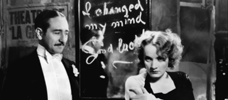
Morocco
1930 -
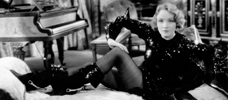
Dishonored
1931 -
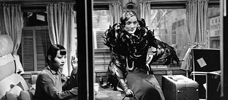
Shanghai Express
1932 -
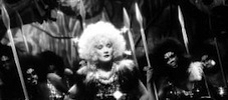
Blonde Venus
1932 -
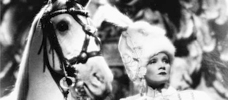
The Scarlet Empress
1934 -
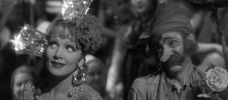
The Devil is a Woman
1935
We don’t do comments anymore, but you may contact us here or find us on Twitter or Facebook.



